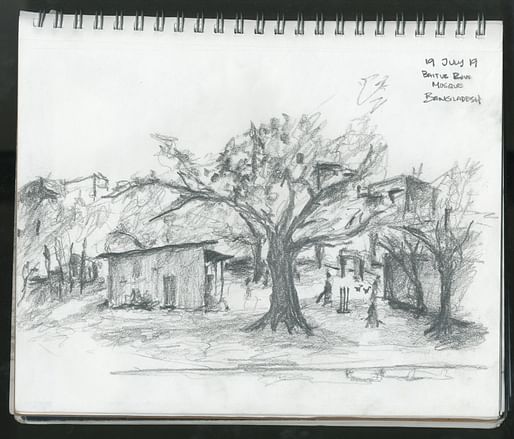
University of Arkansas Fay Jones School of Architecture and Design fifth-year architecture student David Sweere has been awarded the 2019 Aydelott Prize, beating out three other competing Aydelott Travel Award recipients.
The Aydelott Travel Award and Prize have been awarded each year since 2016. The unconventional award program selects four Travel Award winners who are each given $20,000 to visit and analyze four buildings of their choosing, with one student selected from this cohort for the Prize portion of the program. Each student is asked to produce an essay documenting and analyzing their research and these essays are what is judged to determine who is ultimately awarded the Aydelott Prize.
The award was created in part to highlight the talent emanating from schools in the southeastern United States and due to this fact, only students from University of Arkansas, Auburn University, Mississippi State University, and the University of Tennessee are allowed to apply.
The award is named after benefactors Alfred Lewis and Hope Galloway Aydelott and aims to "help architecture students develop effective analytical skills," in addition to highlighting promising students from these professional architecture programs. Alfred Lewis Aydelott was a successful Modernist architect and artist from the Deep South who practiced in Memphis, Tennessee and is known for designing many spectacular mid-century structures, including the Brutalist Pet Plaza in St. Louis and the United States Embassy in Manila, the Philippines.

The students who received the Adelott Travel Award alongside Sweere include: Mike Lidwin of the University of Tennessee, Henry Savoie of Auburn University, and Sarah Hoing of Mississippi State University.
During the summer of 2019, Sweere traveled to the Therme Vals in Vals, Switzerland, designed by Peter Zumthor; Steilneset Minnested in Vardø, Norway, designed by Peter Zumthor and Louise Bourgeois; Can Lis in Mallorca, Spain, designed by Jørn Utzon; and Bait Ur Rouf Mosque in Dhaka, Bangladesh, designed by Marina Tabassum. These travels helped Sweere produce a 103-page essay titled An Emotional Reconstructive Architecture that, according to the University of Arkansas website, "focused on the interior sensory experiences of architecture that are derived from place, and how these spaces have the power to move people on emotional and spiritual levels."
Regarding Sweere's selection, Peter MacKeith, Dean of the Fay Jones School writes, "The Aydelott Prize and Travel Awards program is a superb means of recognizing the excellence of architecture education and architecture students away from the presumed centers of architecture culture. Here in the heartland, in these four great schools, there is both a legacy and a contemporary vitality of design talent: hard-working, thoughtful, authentic and sophisticated at the same time. David Sweere is the epitome of such a student, and the award of the Aydelott Prize to him after his summer of travel, sketching, writing and reflecting on the nature of architecture is definitive confirmation of his abilities and his promise in architecture. His proposal augured well for such an accomplishment, and the overall documents and material resulting from his creative and intellectual journeys are superb. The entire faculty and staff of the school join me in congratulations to this leading student."
During his travels and research, Sweere received advice and guidance from Fay Jones School-affiliated educators, including Robert McCarter, Marlon Blackwell, Kenneth Frampton, and Juhani Pallasmaa, all architects and design educators who have a relationship with the Fay Jones School.
Describing his research, Sweere explains that "There's a subtlety in every mark that goes into the feeling and your interpretation of the place. So you can relay it better I think through drawings than photographs, but you also experience it more fully yourself through forcing yourself to draw it, and draw it again and again and again."
"It was already the architecture that I was most interested in because of these place-based qualities, because of the light quality that these buildings have," Sweere continued, adding, "But getting to go and experience them, it gives you another level of attachment to the buildings so you really get to know what they are all about. And you can start to flesh out where the ideas came from that the architect was working with."
No Comments
Block this user
Are you sure you want to block this user and hide all related comments throughout the site?
Archinect
This is your first comment on Archinect. Your comment will be visible once approved.